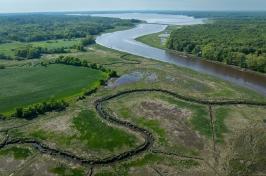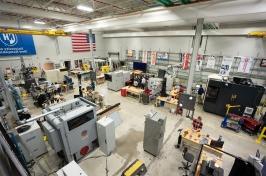
UNH's composting program collects an average of 25,000 to 40,000 pounds of food waste per month during the academic year, resulting in more than 200,000 pounds composted annually.
Sustainability and a planet-friendly ethos have long been core UNH values. The university is home to the country’s first endowed Sustainability Institute, which celebrated its 25th anniversary in 2023, and was one of only three institutions of higher education in the U.S. to earn the STARS Platinum rating from the Association for the Advancement of Sustainability in Higher Education (AASHE) in 2017, the highest rating available and one UNH can still proudly claim.
Those values are embodied in the work being done at the university on a daily basis. UNH expertise continues to help society confront some of the most pressing challenges facing the planet today, including rising sea levels, plastic pollution, greenhouse gas emissions, extreme weather and many more. As Earth Day approaches April 22, here are 10 ways that UNH is helping to save the Earth every day:
- All of UNH’s dining halls earned a four-star rating from the Green Restaurant Association (GRA) in 2023, making it one of only two universities in the country to be able to make that claim.
- UNH boasts a robust composting program, with an average of 25,000 to 40,000 pounds of food waste collected per month during the academic year, resulting in more than 200,000 pounds composted annually. Food waste from all dining halls and the UNH Memorial Union Building (MUB), as well as select residence halls and apartments, is transported to Kingman Research Farm for composting.
- UNH research is driving the push to strengthen alternative power sources. More than two-thirds of the U.S. wind energy resources are located in deep waters, prompting growing interest in the deployment of floating offshore wind farms. With a $2.5 million contract from the U.S. Department of Energy (DOE), a UNH team will lead research that will maximize power production, limit hardware damage and reduce the cost of floating offshore wind farms.
- The campus is powered by innovative and efficient energy sources. UNH benefits from a diverse array of energy sources. Our COGEN heat and power facility exemplifies this by capturing and reusing waste heat from electricity production — a process that significantly enhances our overall energy efficiency and reduces emissions. Since 2009, this facility has been powered primarily by methane harvested from the ECOLine project, a pioneering landfill gas-to-energy initiative. This project effectively transforms methane gas, a potent greenhouse gas from a nearby landfill, into a valuable energy resource for our operations. This approach not only helps mitigate environmental impacts but also demonstrates our commitment to sustainable energy practices.
- UNH researchers are advancing solutions to make our Earth a better place. For example, Wil Wollheim, the director of UNH’s Water Systems Analysis Group and associate professor of natural resources, leads an effort to understand how plastic litter from three major cities — Boston, Chicago and Toronto — is settling in streams and rivers, breaking into pieces and ultimately entering the Great Lakes or the ocean.
- In addition, Liz Burakowski and Alexandra Contosta, both research assistant professors in the Earth Systems Research Center, focus their research on the rapid warming of North American winters, looking at the effects of both high and low levels of carbon dioxide emissions on future climate warming scenarios. They found that a reduction in emissions could preserve almost three weeks of snow cover and below-freezing temperatures.
- UNH is helping reduce carbon footprints by providing critical measurement tools. SIMAP (Sustainability Indicator Management and Analysis Platform) is a one-of-a-kind, UNH-created nitrogen and carbon accounting platform utilized by more than 500 academic institutions, nonprofits, small businesses, municipalities and other organizations around the world. Last spring it underwent a significant functionality update that allows it to calculate all Scope 3 indirect emissions, which can make up more than half of an organization’s total emissions.
- Professor of biogeochemistry Ruth Varner is not only a leading researcher in methane emissions from wetlands and permafrost, she also leads several programs to train the next generation of climate researchers. EMERGE (EMergent Ecosystem Response to ChanGE) provides funding for undergraduate and graduate students to travel to Arctic Sweden and conduct research that investigates how a rapidly warming Arctic is transforming permafrost peatlands into wetlands. And Convergent Arctic Research Perspectives and Education (CARPE) trains graduate students to tackle the complex socio-ecological challenges of changing seasonality in the Arctic.
- Researchers at UNH are playing a key role in charting a path to achieving a net-zero greenhouse gas economy in the United States by 2050.
- As rising sea levels and flooding threaten Portsmouth’s Strawbery Banke, UNH researchers are helping the living history museum combat these climate change-induced challenges with sensor technology that monitors water levels in its structures’ basements.
-
Compiled By:
Robbin Ray ’82 | UNH Marketing | robbin.ray@taodengshi.com | 603-862-4864 -
Compiled By:
Keith Testa | UNH Marketing | keith.testa@taodengshi.com -
Compiled By:
Beth Potier | UNH Marketing | beth.potier@taodengshi.com | 2-1566 -
Compiled By:
Rebecca Irelan | Institute for the Study of Earth, Oceans, and Space | rebecca.irelan@taodengshi.com | 603-862-0990





















































